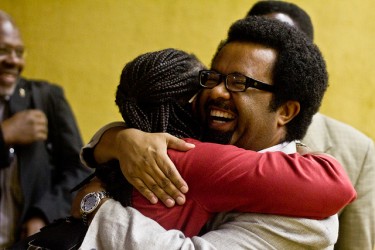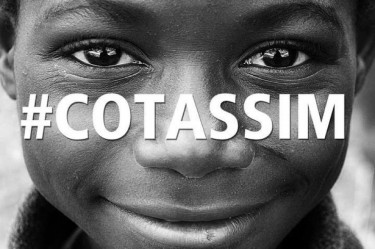This post is part of our special coverage Indigenous Rights.
[All links lead to Portuguese language pages except when otherwise noted]
On April 26, 2012, in a plenary session of the Supreme Court of Brazil, the adoption of racial quota policies in higher education institutions across the country was unanimously approved. With this approval, universities, colleges and educational institutions are legally allowed to devote a specific percentage of places for students of African and/or indigenous origin.
The approval of the policy brings up again the controversial debate [en] on racial discrimination and racial inequality in the country, promoting important reflections and divided opinions.

Commemoration of the judgment of the Supreme Court on affirmative action. Photo of Emily Silberstein (CC BY 2.0).
The measure is a reflection of affirmative action policies being constitutional in the country since democratization in 1988. Diana Costa, on her blog, says that the “discriminatory process [that] affects people negatively are marked by stereotypes that consolidate them as socially inferior, incapable, degenerated, etc., allocating them in situations of sub-citizenship and civil risk.”
She also explains what affirmative actions are:
É um conjunto de políticas que compreendem que, na prática, as pessoas não são tratadas igualmente e, consequentemente, não possuem as mesmas oportunidades, o que impede o acesso destas a locais de produção de conhecimento e de negociação de poder.
The blog Religiões Afro Brasileiras e Política (Afro Brazilian Religions and Policy) says that the result of affirmative action policies in the country through the quota system has already shown results of “a notorious growth in the proportion of graduated blacks and pardos [approximate translation: brown, coloured]”, between 1999-2009, according to IBGE data (Brazilian Institute of Geography and Statistics).
The University of Brasilia (UNB) was the first educational institution to adopt the measure when, in 2004, it started reserving 20% of its university places exclusively for blacks, and some other amount for Indians, without the entry requirement of taking the regular university exam. The Democrats Political Party (DEM) started a lawsuit against UNB in 2009 for considering the racial quota system a kind of racial court (to judge people's race by the colour of their skin). But since UNB adopted the measure, several other higher education institutions also started adopting the quota system.
To make the search process easier, the NGO Educafro provides on its website a complete list of institutions offering quotas for public school students, black students, indigenous students or students with disabilities.
#CotasSim vs. #CotasNao (#YesQuotas vs. #NoQuotas)
Many people celebrated the unanimous approval of the adoption of the quota policy. During the vote, the Supreme Court ministers themselves were very positive about the decision. According to Minister Joaquim Barbosa, the only black among those who voted, “these measures are intended not only to combat manifestations of blatant discrimination, but discrimination in fact, that is absolutely rooted in society, and so ingrained, people do not perceive it”, reported G1.
Journalist and teacher Jeso Carneiro also celebrated the decision. In his blog, he said that:
O STF (…) honrou sua importante missão de defender a supremacia da Constituição. A decisão da corte máxima do país é uma vitória de toda a sociedade brasileira, especialmente do movimento negro, que, desde a década de 1980, vem defendendo com firmeza a aplicação de ações afirmativas para combater o racismo e a exclusão social dos negros neste país.
On Twitter, through the hashtag #CotasSim, statements of support were intense.
Musician Sany Pitbull (@SanyPitbull) wrote:
A elite Branca brasileira tem uma divida à ser paga aos negros, aos pobres, aos índios e aos nordestinos desse país #cotassim
Blogger and historian Conceição Oliveira (@maria_fro) added:
Cotas não inventa a racialização bando de hipócritas, a racialização já existe em um país racista que segrega jovens negros #CotasSim
However, not everyone agrees with the decision of the Supreme Court. Videoblogger Daniel Fraga argues in this video that in a country such as Brazil, where racial mixing is very high, it would be difficult to correctly define who really is black or white. This decision would be made based on a “visual criteria,” and mentions UNB's case of two twin brothers, one considered white and the other black, the latter gaining a quota place at the university.
Others argue that the quotas would only be an easy way out for the poor public primary and secondary education system, a claim refuted in an article published by the Federal University of Minas Gerais, which says that “it is a big mistake to think that in the field of democratic public policies, advances are produced by sequential steps: first, improve basic education, and then democratize the university. Both challenges are urgent and need to be taken emphatically and simultaneously.”
The approval also generated racist statements. On April 29, a shop in front of the Federal University of Minas Gerais (UFMG) had a wall spray-painted with the words: “UFMG will turn black.”
Blog Brasil Escola explains the importance of a better understanding of racism in Brazil for understanding affirmative action policies in the country:
(…) a miscigenação não exclui os preconceitos. Nossa última constituição coloca a discriminação racial como um crime inafiançável. Entre nossas discussões proferimos, ao mesmo tempo, horror ao racismo e admitimos publicamente que o Brasil é um país racista. Tal contradição indica que nosso racismo é velado e, nem por isso, pulsante. Queremos ter um discurso sobre o negro, mas não vemos a urgência de algum tipo de mobilização a favor da resolução desse problema. Ultimamente, os sistemas de cotas e a criação de um ministério voltado para essa única questão demonstram o tamanho do nosso problema. Ainda aceitamos distinguir o negro do moreno, em uma aquarela de tons onde o último ocupa uma situação melhor que a do primeiro. Desta maneira, criamos a estranha situação onde “todos os outros podem ser racistas, menos eu… é claro!”. Isso nos indica que o alcance da democracia é um assunto tão difícil e complexo como a nossa relação com o negro no Brasil.
The discussion will continue in the coming weeks since, besides this action, the Supreme Court is yet to decide the constitutionality of racial quotas when applied to a student who attended public school. It is worth noting that quotas are not mandatory – every educational institution may choose to adopt the policy or not. The University of São Paulo (USP), the largest higher education institution in Brazil, for example, does not use it.
This post is part of our special coverage Indigenous Rights.








5 comments
The discussion will continue in the coming weeks since, besides this action, the Supreme Court is yet to decide the constitutionality of racial quotas when applied to a student who attended public school
What an interesting thought…
plagiarismdetect